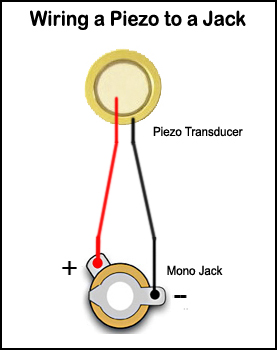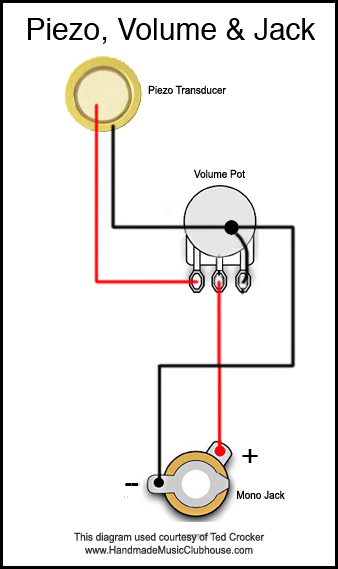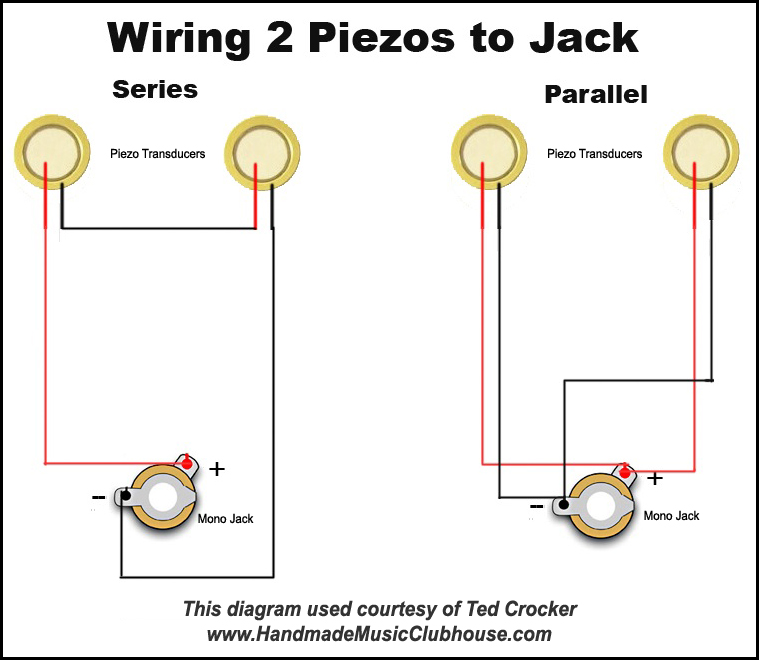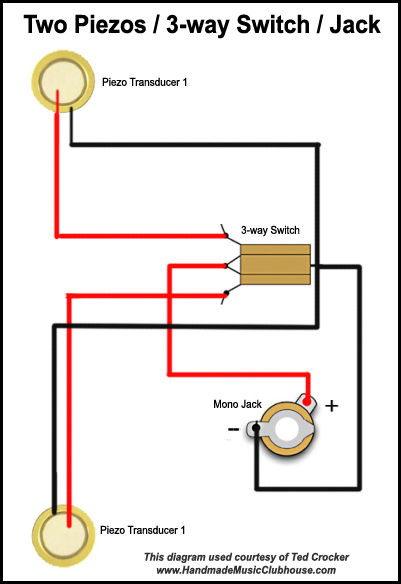4 Ways To Electrify Your Cigar Box Guitars With Piezo Pickup Harnesses [Diagrams Included]
Are you intimidated by how to electrify your cigar box guitar with piezos? Need a little help to understand exactly how to wire a piezo pickup harness of your own?
Wiring a cigar box guitar (CBG) with piezos can be a daunting task – but it doesn’t have to be.
In fact, with a handful of visual aids, you can see just how to wire together a piezo transducer (pickup) harness and confidently electrify your CBG.
In this article you’ll find four simple wiring diagrams, created by Ted Crocker, and detailed explanations to help you understand how the piezo harnesses work.
Armed with this knowledge, the basic concepts presented here can be built upon and experimented within your own building adventures, and with terrific results.
To make electrifying your CBG with a piezo pickup pain-free and a whole lot of fun, you’ll find four diagrams in this article detailing how to wire the following harnesses:
- a simple piezo to jack setup
- a piezo to jack with a volume pot added in
- piezos wired in series and parallel to a jack
- and a dual piezo setup that includes a 3-way switch for switching between the two piezos
Plus, here’s a bonus tip before get started – to make installing a piezo pickup harness in your CBG as easy as possible, use a jack with a long, threaded shank that will reach through the side of a cigar box.
The Neutrik-brand jacks we sell in our web store are selected specifically because they have a nice 9.5mm shaft-length, perfect for getting through a cigar box side with a minimum of gouging and thinning.
Well, enough talk, let’s get started!
Diagram #1: Wiring a Piezo to a Jack

This diagram shows the most basic wiring setup you can get: a single piezo wired directly to a mono (two pole) jack.
This is the setup that many first-time CBG builders use when looking to plug their build into an amp.
Many builders stick with this basic setup and never feel the need to get any fancier – and there is nothing wrong with that!
This setup will give you a very straightforward sound, which is dependent on where the piezo is placed and how it is mounted in the box.
One question that gets asked a lot is whether the polarity of what piezo wire you connect to which pole on the jack matters.
Or in other words, does it matter which pole on the jack you wire the red or black wire to?
The simple answer is that no, it doesn’t – you will get the same sound regardless of how you connect it.
However, it's a good habit to always connect the ground (black wire) to the ground pole.
With a straight piezo-to-jack harness it isn’t critical, but as wiring jobs get more complex it makes troubleshooting much easier if you are consistent throughout!
The only other thing to note is that some piezos come with pretty short wire leads (in the range of 2 inches) that you will have to extend to reach your jack.
Since piezos do not require any special shielded wire, pretty much any kind of small-gauge copper wire will do.
Ready to wire your own piezo pickup harness?
Diagram #2: Piezo, Volume Potentiometer and Jack

This setup builds upon the concepts of the last diagram but adds one little twist – a volume potentiometer (pot) that allows you to control the output volume of the signal in the same way that a volume knob on your stereo does.
Really, a pot is just a variable resistor that increases or decreases the total resistance as you turn it, which in turn allows more or less current through the circuit.
There are two main types of potentiometers available on the market, identified by the type of their “taper” – audio taper, and linear taper.
We recommend always using audio taper pots for volume controls, as they will give you a smoother rate of increase and decrease.
Also, for a piezo volume control, a resistance rating of either 250K Ohms or 500K Ohms is recommended, with 500K Ohms being the one most builders go with.
As you can see from the diagram, one of the piezo leads (red) is wired to the first terminal of the pot, and then continues off of the second contact and on to the jack. The other (black) is wired to the third contact of the pot and then on to the jack.
As mentioned above, pretty much any smaller-gauge copper wire can be used for this purpose, and shielded wire is not required. Be careful when soldering to a pot though, as it is possible to burn them out with too much heat.
That’s about it for this diagram. When wired up in this way and plugged into an amp, the total volume output by the piezo will be controlled by the potentiometer.
Properly installed into a cigar box guitar, this will allow the player to make on-the-fly adjustments from the instrument, which definitely has its uses.
Pots are pretty cheap and as we’ve seen they are not that hard to wire in, and can really be a nice extra touch for your CBG, especially from the player’s point of view.
Ready to wire a volume control into your piezo pickup harness?
Get potentiometers (pots) for your volume controls here.
Diagram #3: Wiring Multiple Piezos to a Jack

This diagram shows two ways that multiple piezos can be wired to a single jack. It involves some basic electrical circuit theory – the concept of wiring in parallel and wiring in series.
Basically, wiring in series means attaching two or more components “end to end”, so that a single pair of wires ends up at the terminal, in this case the jack. The left portion of the diagram illustrates this: one lead from each piezo runs to the jack, and the other two leads are connected together.
This, in effect, means that the electrical current that gets translated into sound always travels through both piezos, so that each affects the signal of the other.
The effect of wiring in series is to increase the total impedance of the circuit, which can definitely have an effect on sound – a topic that is too advanced for this article.
Wiring in parallel differs in that each component has its own leads that run back to the terminal.
As shown in the right side of the diagram, each piezo’s leads are directly connected to the jack. So instead of a single signal running through both piezos, each piezo sends its own distinct signal back to the jack, where they join and run to the amp.
There is some divided opinion among builders as to which is better, though in our opinion you will usually get better results with wiring in parallel as opposed to in series.
In general, the higher the impedance of a circuit, the less current flows and that translates to less volume.
But as with most things related to cigar box guitars, the best way to decide is to try both and see which sounds better to you.
A good “controlled’ experiment would be to mount two piezos in a cigar box guitar build that has the inside accessible (the box hasn’t been permanently sealed); then try them wired in parallel versus in series, and see which sounds better to you.
Diagram #4: Multiple Piezos, 3-way Switch & Jack

This diagram is the most advanced one yet, and the final one we will cover in this article. It involves the use of two piezos, a three-way switch and a jack.
The purpose of the circuit is so that you can have two piezos in two different locations in your instrument, and switch between them while playing.
In the far left (or right, depending on your wiring) switch position, you would have just the signal from piezo#1 getting to the amp.
In the far right position, you would have just piezo #2.
And in the center position, you would have both piezo one and two in parallel.
This is similar to how electric guitars allow you to switch between different magnetic pickups, or blend them together, for different tonal qualities.
It should be noted that the black wires all are joined to the switch chassis on the right side of the switch in the diagram, while the red wires each are wired to a separate terminal, with the center terminal being the one that runs to the jack.
The black wires are attached only as a “ground”, and they should not in any way make contact with the red “hot” wires. While it’s not always necessary to ground the black wires, it is a good habit to get into.
To take this concept further, to add a volume pot to this circuit, you could either add it between the switch and the jack, for a “master” volume control, or you could get even more adventurous and add two separate volume controls, one for each piezo.
These would go between each piezo and the switch, and would allow a great deal of fine-tuning of the signal coming from each one.
This diagram could also be expanded to support more piezos – either wired in series or in parallel.
There are also switches available with more than three positions, which would allow even more flexibility (and wiring complexity) – but to be honest, we think there comes a point with a cigar box guitar where one has ventured into the realm of overkill.
But the options are there!
Ready to level-up and wire a 3-way switch into your piezo pickup harness?
Conclusion
Well, this completes our overview of basic piezo wiring diagrams for cigar box guitars.
In this article you learned how to wire...
- a simple piezo to jack setup
- a piezo to jack with a volume control
- piezos wired in series and parallel to a jack
- and a dual piezo setup that includes a 3-way switch for switching between the two piezos
We hope that you have found it to be helpful, and that if you have been on the fence about wiring up your CBG you are now ready to dive in!
There is of course a lot more that could said about this topic, and much more advanced diagrams that could be offered.
We leave it up to you to experiment to your heart’s content, and see what kind of intriguing sounds you can produce.
As we often say with cigar box guitars, there are no rules.
If you try something and don’t like it, rip it out and try something else!
Of course when it comes to electronics, this is a lot easier if you don’t permanently seal your box. But if you did – well, it’s a great excuse to build another one!
Which piezo pickup harness you learned about here will you use in your next cigar box guitar build?
More Must-Reads
Uncover all there is to know about disk piezo pickups and cigar box guitars.
Check out the following 2-part series on piezo pickup basics...
Piezo Pickup Basics: Using Disk Piezos In Cigar Box Guitars - Part 1
Are you struggling with how to use a disk piezo pickup in your cigar box guitar? Do want to electrify your CBG with a piezo but don't know where to start?
This is the first article in a two-part series that gives you the bare-bones "here's what you need to know" information to help you install a disk piezo pickup in your next cigar box guitar build.
Click here to start part 1 of this series.
Piezo Pickup Basics: Using Disk Piezos In Cigar Box Guitars - Part 2
Confused about where in your cigar box guitar to install a disk piezo pickup? Or perhaps how to install one?
Those questions and more are answered in this second article of a two-part series about using disk piezos in cigar box guitars.
Click here to access part 2 of this series.
Recent Posts
-
New Seasick Steve Song + How to Play It on Cigar Box Guitar
Seasick Steve is back with his 4-string cigar box guitar and just launched a brand new video for the …24th Apr 2024 -
2024 Double-Neck Cigar Box Guitar Build-Off! $500 in prizes!
Why should Led Zeppelin or Rush have all the fun? We build cigar box guitars... so let's make …22nd Apr 2024 -
How to Get Free Stuff with Your C. B. Gitty Order
Shopping for your instrument parts can be just as fun as building the instrument, especially when th …6th Mar 2024

![4 Ways To Electrify Your Cigar Box Guitars With Piezo Pickup Harnesses [Diagrams Included] 4 Ways To Electrify Your Cigar Box Guitars With Piezo Pickup Harnesses [Diagrams Included]](https://cdn11.bigcommerce.com/s-jpvnhi/images/stencil/1193x795/uploaded_images/featured-image-for-piezo-pickup-harness-wiring-diagrams-1-.png?t=1551810177)




